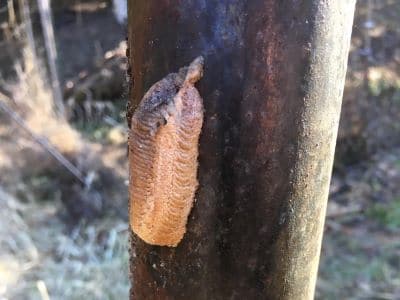O LORD, what a variety of things you have made! In wisdom you have made them all. The earth is full of your creatures. Psalm 104:24 NLT
Some years ago, I went to our county extension service and obtained plans to build a bat box. I was tired of the mosquitoes which plagued our backyard each summer, and since I’m not much for spraying poisons, I thought I’d try a more natural solution to knock down the evening insect population. If you know anything about bat boxes, they need to be elevated about 12 feet or more to keep predators like raccoons out of them.
I put the bat box on a metal pole at the edge of our garden. It took a few years to attract the bats, but I must say they have done a marvelous job at reducing the mosquito population around our home. I have tried – unsuccessfully – to capture a picture of the bats as they drop out of the box in the evening, and wing their way into the night on their nocturnal insect hunt.
Not long ago, I noticed a praying mantis egg-casing firmly attached to the bat box pole. Female mantis will lay their eggs in the fall in my part of the world. They cover their eggs with a protective casing, as seen in the above photo. This casing helps shelter the developing eggs from rain and snow and freezing temperatures. There may be several hundred eggs in one casing, depending upon the species and size of the mantis.
The eggs will hatch in the spring when the snow melts and temperatures begin to rise. As the small mantis eggs hatch and emerge from the egg casing, they look like tiny pale worms or larvae. Soon they molt and look like miniature adults. They quickly begin to eat whatever they find available – and sometimes it is their sibling hatching a few moments after them! They weigh very little at this time, so if a breeze is blowing, the young have a better chance of survival since they will often be carried away by the wind before an older brother or sister has a chance to consume them.
By the end of their life cycle, a very small percentage of these emerging mantis will reach adulthood. Just enough to keep the population going for the next year. The lifespan of an adult praying mantis is about 4-6 months in a cold climate, and up to a year in the tropics. In captivity they have been known to live up to two years or more.
When I go outside, I don’t have to look far to see some of the marvelous things the Lord has made. Often, I don’t even have to get out of my backyard. If you don’t know how to have an everlasting relationship with the Creator of the universe, I encourage you to check out Got God?
Hope you have a great day.
